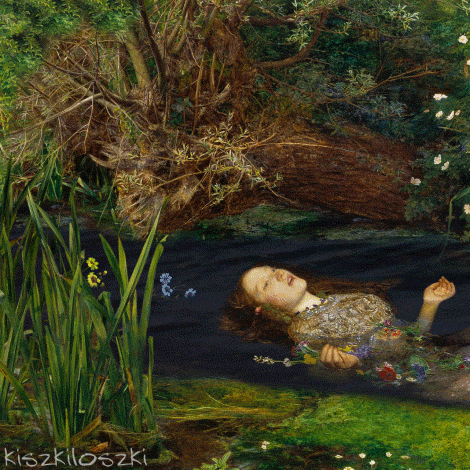Fanny Eaton was an amazing woman. She moved from Jamaica to London, where she became a model for the pre-Raphaelite Brotherhood (them famous dandy painting types). But before we get to that bit, let’s give you some background.
IN THE BEGINNING
Fanny was born in 1835. Her mother, Matilda Foster, was an ex-slave, but no father is mentioned on Fanny’s birth certificate. There’s a theory that her father was a slave owner—sadly, this was not an uncommon occurrence.
There’s also suggestion that Fanny’s dad was a soldier named James Entwhistle or Antwhistle (Fanny’s maiden name), who died at the age of just 20 in Jamaica. But either way, her dad wasn’t in the picture.
Matilda and Fanny moved to London sometime during the 1840s, and in 1857, Fanny married a hot young cab driver named James Eaton (GO FANNY!).
Fanny mostly worked as a cleaner/domestic servant in London, but she had a side job working as an artist’s model. COVERGIRL!
Fanny was mixed race and was, by all accounts, a total stunner—so it’s no surprise she caught the eye of many an artist.
The first sketches and paintings of Fanny are attributed to artist Simeon Solomon. In fact, the first painting featuring Fanny was The Mother of Moses by Simeon Solomon, which was exhibited at the Royal Academy in 1860. FANNY HAD MADE IT!
 The Mother of Moses by Simeon Solomon, 1860
The Mother of Moses by Simeon Solomon, 1860
While working, Fanny caught the eye of some of the Pre-Raphaelite Brotherhood.
“Who are they?” I hear you cry. Well, these guys were a bunch of Bohemian painters who loved nothing more than hanging out and painting super dreamy babes in big elaborate scenes pulled from the Bible or popular myths.
The core founding group was made up of William Holman Hunt, John Everett Millais, and Dante Gabriel Rosetti, but they had roughly a metric shit-ton of associated artists. They were influenced by medieval art and wanted to focus on details and complex scenes rich with imagery.
 Gif version of Ophelia by Millais
Gif version of Ophelia by Millais
Now, the Pre-Raphaelite Brotherhood considered Fanny a total fucking hottie, because—duh—they had working eyes. She was a favorite among them. In a letter to his artist mate Ford Maddox Brown, Rosetti wrote that Fanny had a “very fine head and figure.”
NO SHIT, MATE!
 The Beloved by Dante Gabriel Rosetti, 1865-66; Fanny is the third bridesmaid from the left
The Beloved by Dante Gabriel Rosetti, 1865-66; Fanny is the third bridesmaid from the left
One of the most famous paintings of Fanny was The Head of Mrs Eaton by Joanna Boyce Wells (sister of Pre-Raphaelite artist George Boyce).
 The Head of Mrs Eaton by Joanna Boyce Wells, 1861
The Head of Mrs Eaton by Joanna Boyce Wells, 1861
Sadly, Joanna died tragically young, just as her career was starting to take off. So we don’t know the true story behind her work with Fanny. But the portrait of Fanny was thought to be a study for a larger painting that would depict Fanny as a Libyan prophetess or a Syrian warrior queen (both sound fucking amazing).
 “The Young Teacher” by Rebecca Solomon, 1861
“The Young Teacher” by Rebecca Solomon, 1861
The last painting of Fanny was Jephthah by John Everett Millais.
 Jephthah by John Everett Millais, 1867 (Fanny is on the far right, wearing a yellow hood)
Jephthah by John Everett Millais, 1867 (Fanny is on the far right, wearing a yellow hood)
Fanny worked as a model for classes at the Royal Academy from 1860 to 1879, and after that life got in the way…you see, Fanny had nine children by then.
I repeat: NINE CHILDREN!
FANNY’S INFLUENCE
Fanny’s contribution to the arts was largely forgotten. She was excluded from art history because of her race. The focus always on other Pre-Raphaelite models, like Janey Morris or Lizzie Siddal.
But Fanny is a hugely important figure because she was a black woman whose beauty was celebrated in art. She wasn’t just painted as a token black figure used to make art more “exotic.” The focus was on HER face, celebrating HER beauty.
Fanny was sadly widowed in her 40s, so she brought up her and her husband’s (by now) 10 children on her own and worked tirelessly to provide for them all. She worked as a cook and seamstress, but unfortunately, little else is known about this period in her life.
We do know she lived a long life and died at the grand age of 88. When she died, she was living with her loving daughter and grandchildren.
Fanny is now finally being brought to the forefront of art history—about time! During a time of serious racial prejudice, Fanny was a symbol of beauty. She’s also an example of how varied working-class Victorian culture was: History is often white-washed, but Britain has always been a melting pot of mixed cultures and influences.
Fanny is a symbol of black beauty during a time of rigid ideals of what women should be. Long may we celebrate her for that!
top image: Sketches of Fanny Eaton by Walter Fry Stocks, 1859
This post originally appeared on F Yeah History and is reprinted here with permission.
More from BUST
How Civil Rights Activist Mary McLeod Bethune Revolutionized America
How “Female Python” Carol Cleveland Became A British Comedy Legend
The Story Of Chavela Vargas, Barrier-Breaking Singer And Queer Icon


